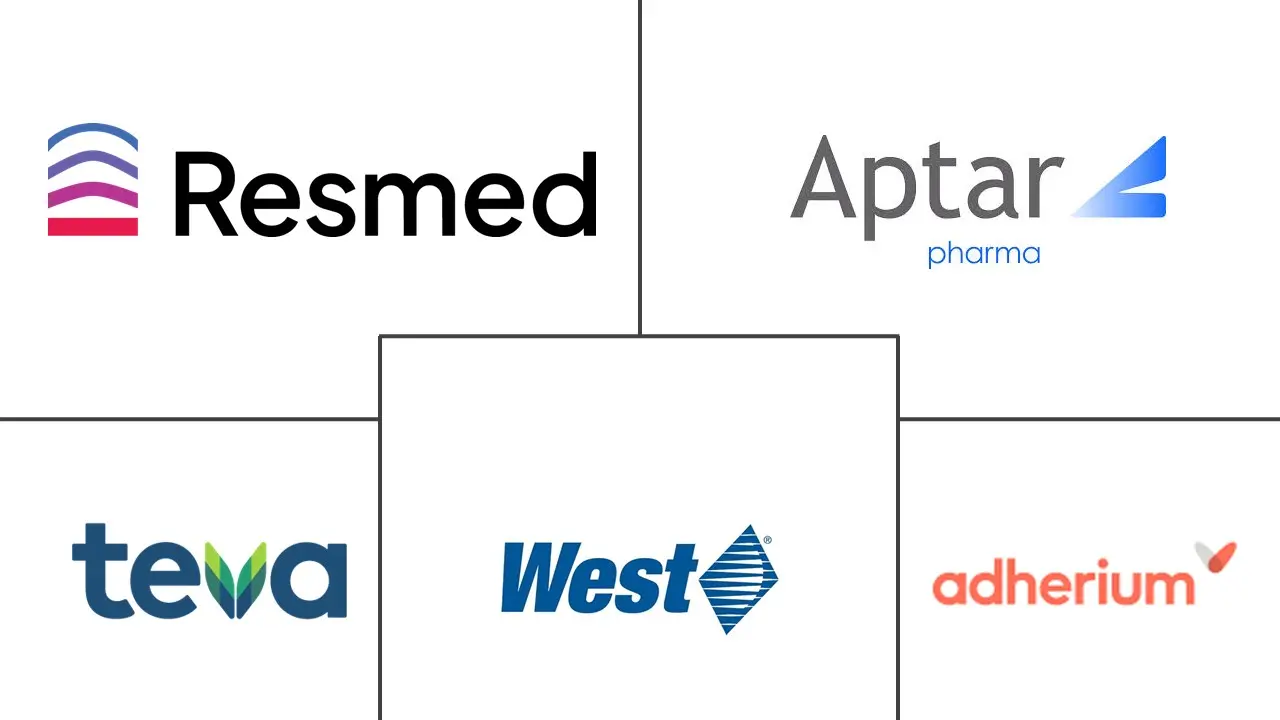Connected Drug Delivery Devices Market Size and Share
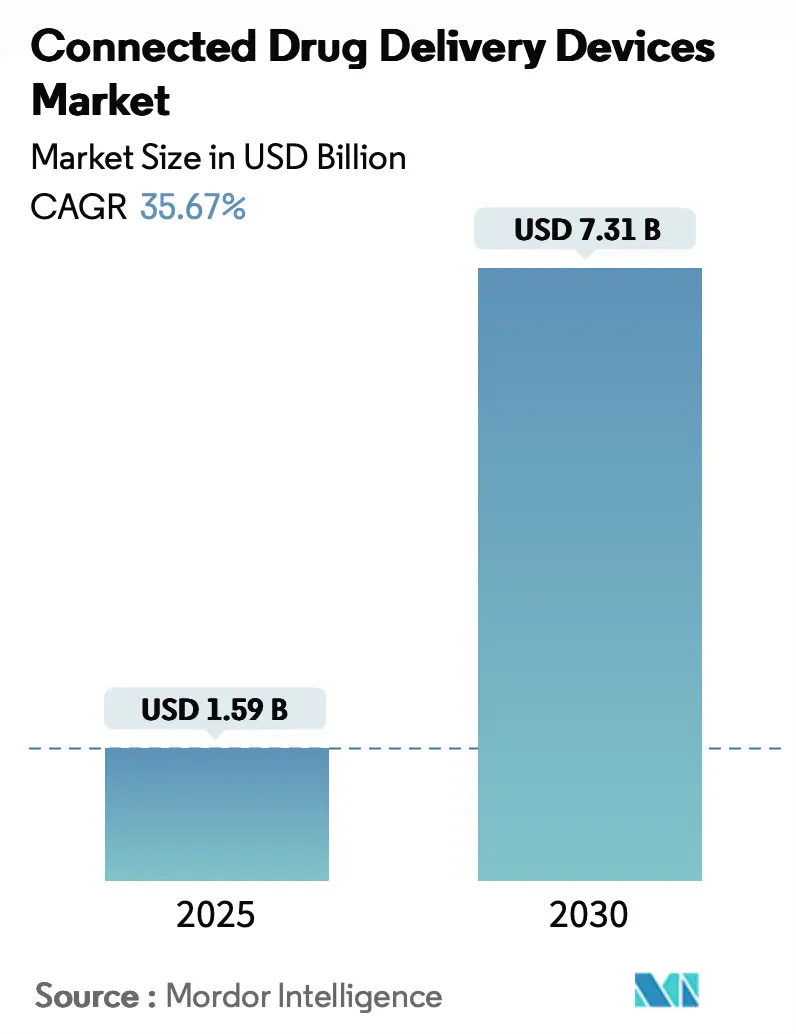
Connected Drug Delivery Devices Market Analysis by Mordor Intelligence
Current valuations place the connected drug delivery devices market at USD 1.59 billion in 2025, and forecasts point to USD 7.31 billion by 2030, equating to a 35.67% CAGR. Continuous expansion aligns with the worldwide rise in chronic illnesses, rapid digital-health uptake, and a regulatory pivot that treats real-world evidence as equal to randomized trials. The FDA’s 2024 Real-World Evidence Program expansion has reshaped how pharmaceutical firms validate device value, while breakthroughs in graphene-based energy harvesting financed by a USD 904,000 federal grant promise battery-free sensors. Parallel progress in value-based reimbursement—confirmed by CMS’s 2025 Physician Fee Schedule—creates direct incentives for adherence-capturing hardware.[1]Centers for Medicare & Medicaid Services, “Calendar Year 2025 Medicare Physician Fee Schedule Final Rule,” cms.gov At the same time, the FDA’s March 2024 draft guidance compels developers to embed robust cybersecurity frameworks into every connected device submission.[2]U.S. Food and Drug Administration, “Cybersecurity in Medical Devices: Quality System Considerations and Content of Premarket Submissions,” fda.gov
Key Report Takeaways
- By product type, Integrated Connected Devices led with 60.36% revenue share in 2024, while Connected Sensors are projected to grow at 36.12% CAGR to 2030.
- By technology, Bluetooth Low Energy accounted for 65.07% of the connected drug delivery devices market size in 2024; NFC is projected to advance at 37.63% CAGR through 2030.
- By end user, Patients/Homecare captured 48.56% of connected drug delivery devices market share in 2024, whereas Healthcare Providers record the highest forecast CAGR at 38.18% to 2030.
- By application, Respiratory Diseases held 50.28% share of the connected drug delivery devices market size in 2024; Diabetes applications are expanding at 39.58% CAGR through 2030.
- By geography, North America led with 44.52% revenue share in 2024, while Asia-Pacific is forecast to grow at 37.56% CAGR to 2030.
Global Connected Drug Delivery Devices Market Trends and Insights
Drivers Impact Analysis
| Driver | (~) % Impact on CAGR Forecast | Geographic Relevance | Impact Timeline |
|---|---|---|---|
| Rising prevalence of chronic diseases | +8.2% | Global, strongest in North America & Europe | Long term (≥ 4 years) |
| Growing demand for remote monitoring & tele-health | +7.8% | Global, earlier in North America & Asia-Pacific | Medium term (2-4 years) |
| Advances in BLE & NFC miniaturisation | +6.1% | Global, tech leadership in Asia-Pacific & North America | Medium term (2-4 years) |
| Direct-to-cloud low-power cellular IoT adoption | +5.3% | Global, infrastructure strengths in developed markets | Long term (≥ 4 years) |
| Energy-harvesting power modules | +4.7% | Global, early roll-outs in North America & Europe | Long term (≥ 4 years) |
| Value-based reimbursement rewarding adherence data | +3.6% | North America & Europe | Short term (≤ 2 years) |
| Source: Mordor Intelligence | |||
Rising Prevalence of Chronic Diseases
Long-term medication courses are replacing acute regimens, pushing developers to craft connected auto-injectors that patients can use at home for complex biologics once limited to infusion clinics. Biogen’s move to subcutaneous forms of LEQEMBI shows how remote dosing broadens access for neurodegenerative therapies. Rare-disease populations spread across geographies also need remote oversight, and real-time biomarker feedback supports personalised dose adjustment. With non-adherence costing the U.S. system USD 100 billion yearly, payers now view connectivity as an economic necessity.
Growing Demand for Remote Monitoring & Tele-Health
Remote platforms now analyse live streams to predict exacerbations before symptoms surface. FDA acceptance of connected device data enables post-market studies that strengthen label claims. Bidirectional tele-health lets clinicians send dosing tweaks directly to devices.[2]U.S. Food and Drug Administration, “Cybersecurity in Medical Devices: Quality System Considerations and Content of Premarket Submissions,” fda.govThe COVID-19 shock compressed adoption cycles, while Japan and Singapore have created accelerated approval lanes that encourage rapid launches. Inhalation systems from MannKind illustrate 5G-enabled, edge-processed feedback loops that support real-time insulin titration.
Advances in BLE & NFC Miniaturisation
Next-generation BLE and NFC chips now run multiple years on coin-cell power. Nordic Semiconductor’s nRF54L platform even embeds edge AI for local analytics. NFC gains traction among elderly users because it eliminates pairing complexity. Multi-protocol packages reduce BoM cost to under USD 2, letting even single-use injectors add connectivity without pricing out payers.
Direct-to-Cloud Low-Power Cellular IoT Adoption
LTE-M and NB-IoT chipsets free elderly patients from smartphone reliance. Nordic’s nRF9160 system-in-package pushes 10-year battery life for low-duty transmissions and integrates an eSIM for seamless roaming. Direct-to-cloud pipelines minimise latency and lower set-up friction, critical for rural or technology-averse users. Built-in cellular encryption also addresses regulators’ data-security demands.
Restraints Impact Analysis
| Restraint | (~) % Impact on CAGR Forecast | Geographic Relevance | Impact Timeline |
|---|---|---|---|
| High device cost vs. conventional disposables | −4.8% | Global, strongest in emerging markets | Short term (≤ 2 years) |
| Cyber-security & patient-data-privacy gaps | −3.2% | Global, regulatory focus in North America & Europe | Medium term (2-4 years) |
| E-waste compliance pressure on single-use electronics | −2.9% | Europe & North America, spreading to Asia-Pacific | Medium term (2-4 years) |
| Lack of interoperability standards across EHRs | −2.4% | Global, greatest in fragmented health systems | Long term (≥ 4 years) |
| Source: Mordor Intelligence | |||
High Device Cost vs. Conventional Disposables
Price gaps of 200-400% versus legacy inhalers or pens deter adoption among uninsured populations. Beyond hardware, ongoing cloud-service fees add recurring expenses. While device-as-a-service bundles offer an alternative, payer skepticism remains high. Market fragmentation prevents scale efficiencies that could compress unit costs. Lack of dedicated billing codes still clouds return-on-investment assessments.
Cyber-Security & Patient-Data-Privacy Gaps
The 2024 FDA guidance mandates threat-model submissions and software bill-of-materials disclosures, raising compliance costs. HIPAA updates proposed for 2025 introduce tougher breach penalties. Global data-transfer laws, including GDPR and emerging localisation rules, further complicate deployment.
Segment Analysis
By Product: Integrated Devices Drive Market Leadership
Integrated Connected Devices represented 60.36% of 2024 revenues, equal to USD 0.96 billion of connected drug delivery devices market size, as pharma companies favour turnkey systems that guarantee measurement accuracy and regulatory alignment. Smart insulin pens form the largest sub-segment; Eli Lilly’s USD 3 billion investment in capacity aims to meet GLP-1 drug demand. Sensor retrofits, although capturing a smaller base, are growing 36.12% a year by enabling connectivity without altering drug formulations.
Connected inhaler sensors, such as Adherium’s Hailie platform, recorded 180% adherence improvement in paediatric tests. Wearable-injector add-ons target large-volume biologics, while injection-pen sensors unlock legacy franchises. Hybrid architectures are emerging, letting firms offer premium integrated devices alongside cost-efficient retrofits within unified dashboards.
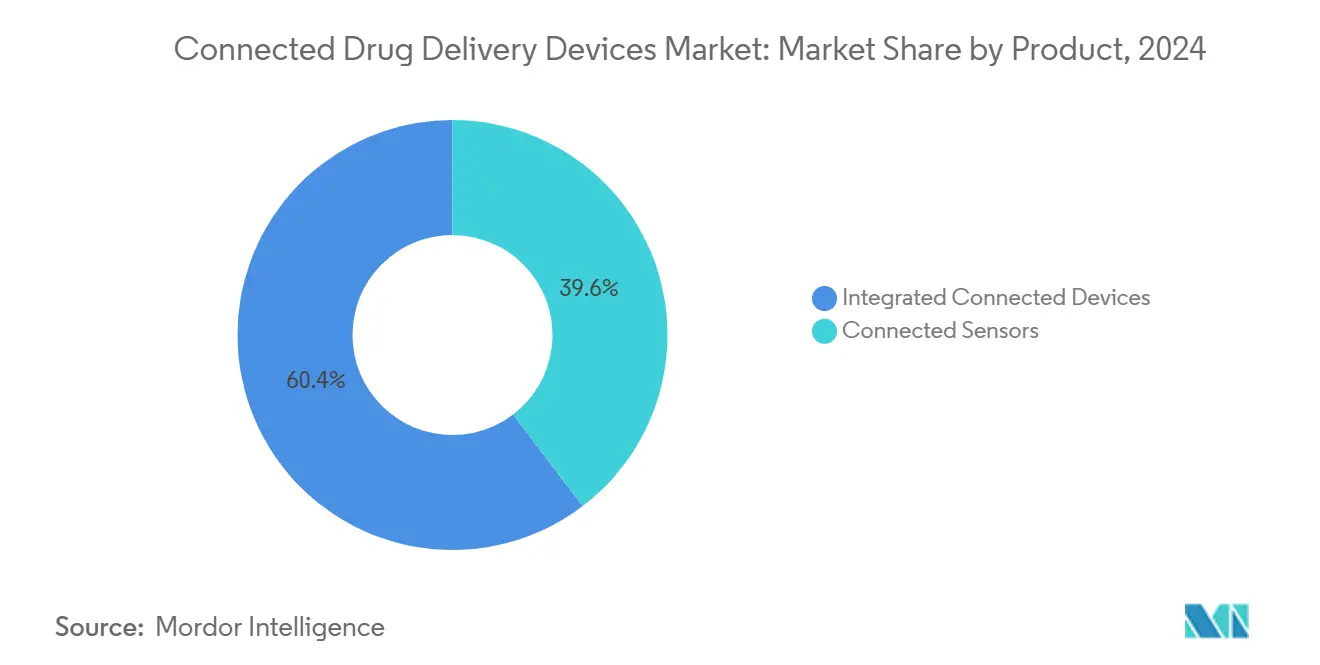
Note: Segment shares of all individual segments available upon report purchase
By Technology: BLE Dominance Faces NFC Challenge
Bluetooth Low Energy commanded 65.07% deliveries in 2024, yet NFC is projected to rise at 37.63% CAGR. NFC’s passive mode curbs standby current to near zero, allowing multi-year lifespan. Short-range comms cut hacking exposure, answering regulator scrutiny. Low-power cellular modules, meanwhile, target global reach without phone pairing, resonating with elderly demographics.
RFID or QR identifiers remain relevant where price sensitivity trumps elaborate connectivity. Multi-protocol chips from Nordic now embed BLE, NFC, Thread, and Zigbee on a single die, equalising bill-of-materials across options and broadening design freedom.
By End User: Healthcare Providers Accelerate Adoption
Patients/Homecare retained 48.56% of connected drug delivery devices market share in 2024, translating to USD 0.77 billion of spending. Provider organisations, however, are growing at 38.18% CAGR under value-based contracts. Hospitals use adherence dashboards to slash readmissions for COPD and heart-failure cohorts; CMS’s new CPT codes fund review time. Pharma companies also deploy devices in decentralized trials to meet real-world data requirements.
Payers and dedicated monitoring platforms form an emerging cluster that integrates device data into care-management decisions. Early movers embed FHIR standards, simplifying multi-stakeholder data exchange mandated by ONC’s HTI-1 rule.
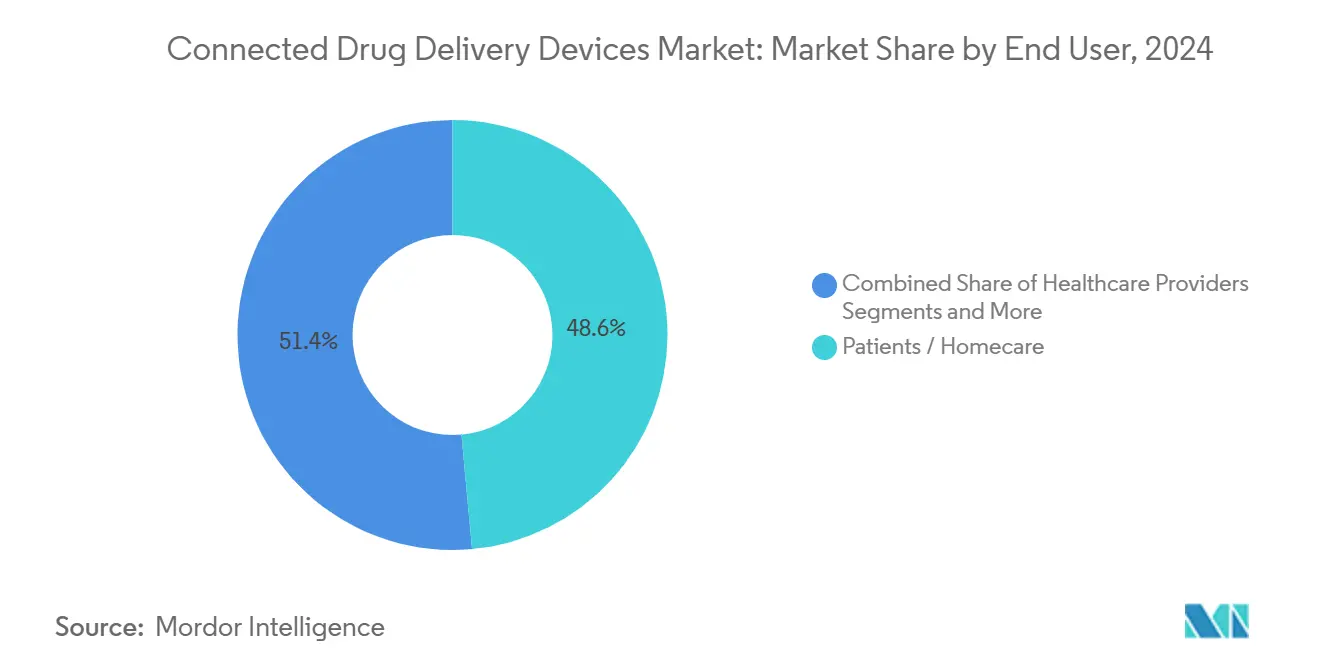
Note: Segment shares of all individual segments available upon report purchase
By Application: Diabetes Growth Outpaces Respiratory Leadership
Respiratory Diseases held 50.28% of connected drug delivery devices market size in 2024, or USD 0.80 billion, thanks to mature inhaler-sensor roll-outs. Diabetes solutions, however, are expanding 39.58% annually as continuous glucose monitors pair with smart pens and automated delivery. Oncology injections make home administration feasible for antibody therapeutics, creating fresh demand. Other chronic segments such as cardiovascular and rare genetic disorders move toward modular platforms that cater to disease-specific sensors with uniform firmware layers.
Gerresheimer’s on-body furosemide pump, cleared in 2024, illustrates the market’s push to reposition hospital-grade therapies into home settings.[3]Gerresheimer, “FDA Grants Tentative Approval of SQ Innovation’s Lasix ONYU,” gerresheimer.comRegulatory clarity via the FDA’s Essential Drug Delivery Outputs guidance accelerates multi-indication approvals.
Geography Analysis
North America’s 44.52% share stems from Medicare coverage, mature EHR penetration, and FDA support for real-world data. CMS reimbursement for adherence monitoring cushions provider investment, while federal cybersecurity guidance sets uniform guardrails. Canada and Mexico leverage regulatory alignment pacts that simplify cross-border launches.
Asia-Pacific is the fastest-growing theatre, advancing 37.56% CAGR. Japan’s PMDA opened a Washington DC office to coach foreign applicants, and China’s record 48 first-in-class drug approvals in 2024 signal growing innovation appetite. Regional semiconductor capacity and pervasive 5G coverage underpin device connectivity. India, buoyed by government incentives for med-tech localisation, shows promise though price controls pose margin pressure.
Europe offers harmonised MDR rules but layers on GDPR and an upcoming AI Act, lengthening compliance cycles. The United Kingdom maintains broad MDR parity post-Brexit yet courts global suppliers with fast-track options. Germany and France anchor substantial demand; Nordic nations experiment with national reimbursement for connected inhalers, spurring early adoption.
South America, the Middle East, and Africa collectively post double-digit growth, driven by rising chronic disease incidence and tele-health pilots. Infrastructure gaps and fragmented reimbursement still temper near-term penetration rates, but global donors fund pilot programs that familiarise clinicians with connected delivery.
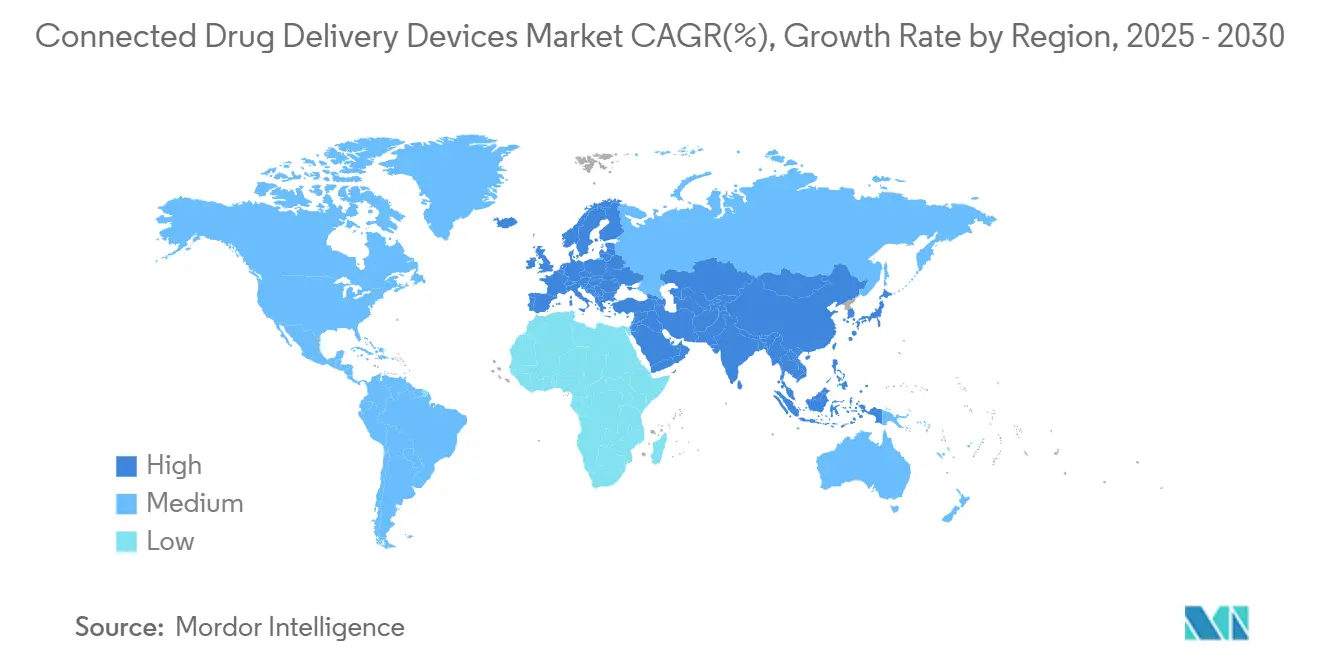
Competitive Landscape
Innovation and Adaptability Drive Market Success
Competition is moderately fragmented; no player exceeds a 10% slice of the connected drug delivery devices market. Traditional giants such as Medtronic and Gerresheimer jostle with digital-first specialists and pharma companies building captive ecosystems. Adherium’s alliances with inhaler manufacturers typify a partnership model that layers sensors onto established drug franchises. Amgen’s collaboration with Amazon Web Services injects generative AI into packaging and assembly, signalling convergence of big-tech and pharma.
Competitive advantage increasingly tracks the quality of analytics and cybersecurity documentation. Firms that master FDA submission know-how and secure component sourcing gain faster approvals. Niche opportunities exist in paediatrics and rare diseases where tailored form factors and small-batch production lock in customer loyalty. Start-ups supplying retrofit sensors disrupt incumbents by lowering entry price, encouraging payers to experiment without large capital outlays.
Connected Drug Delivery Devices Industry Leaders
-
West Pharmaceutical Services, Inc.
-
Adherium Limited
-
Resmed Inc
-
Teva Pharmaceutical Industries
-
Aptar Pharma
- *Disclaimer: Major Players sorted in no particular order
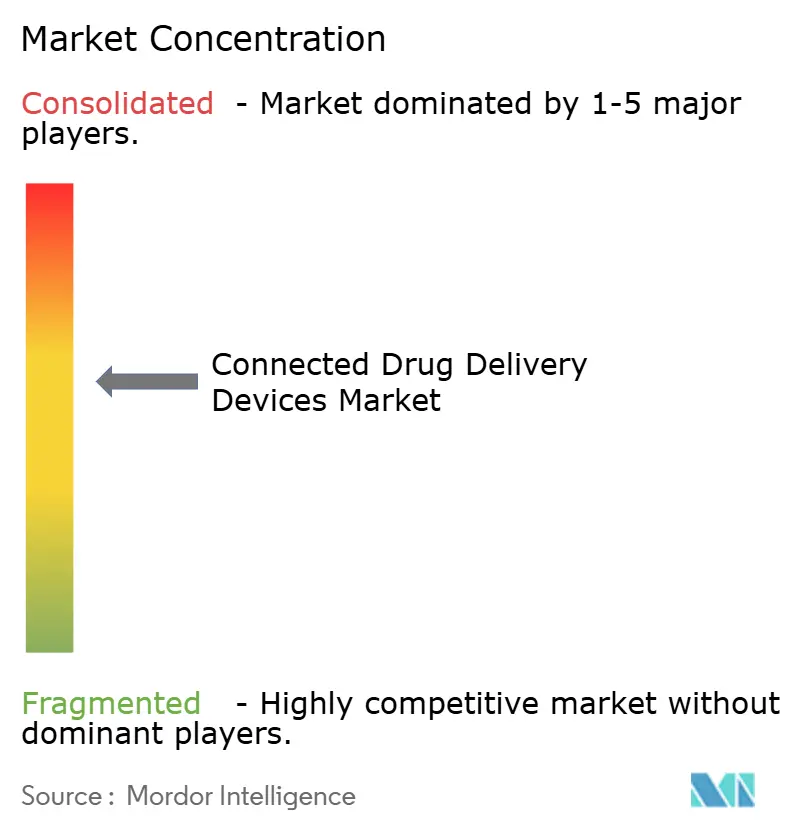
Recent Industry Developments
- May 2025: Enable Injections obtained EU MDR CE-mark for the enFuse Syringe Transfer System, opening sales across the European Union.
- February 2025: Supernus Pharmaceuticals secured FDA approval for ONAPGO, the first subcutaneous apomorphine infusion device for Parkinson’s motor fluctuations.
- December 2024: Gerresheimer won FDA tentative approval for Lasix ONYU, a home-use furosemide micropump enabling sustainable treatment of congestive heart failure.
- November 2024: Medtronic gained FDA clearance for its InPen app with missed-meal detection, aligning with the launch of Simplera all-in-one CGM.
Research Methodology Framework and Report Scope
Market Definitions and Key Coverage
Our study defines the connected drug delivery devices market as every sensor-enabled inhaler, injector, pen, nebulizer, or clip-on sleeve that transmits dose or adherence data via Bluetooth, NFC, or low-power cellular radios to companion software across seventeen tracked nations. We include hardware revenue only, valuing each device at first sale and assigning units to the geography where therapy begins.
Scope exclusion: purely mechanical or single-use products with no wireless data pathway are outside this review.
Segmentation Overview
- By Product
- Connected Sensors
- Connected Inhaler Sensors
- Connected Injection-Pen Sensors
- Wearable-Injector Add-on Sensors
- Integrated Connected Devices
- Connected Inhalers
- Metered-Dose Inhalers
- Dry-Powder Inhalers
- Connected Injection Devices
- Smart Insulin Pens
- Connected Auto-Injectors
- Wearable Injectors
- Connected Nebulizers
- Connected Inhalers
- Connected Sensors
- By Technology
- Bluetooth Low Energy (BLE)
- Near-Field Communication (NFC)
- Low-Power Cellular (LTE-M / NB-IoT)
- RFID / QR Code
- Other Technologies
- By End User
- Healthcare Providers (Hospitals, Clinics)
- Patients / Homecare
- Pharma & Biotech Companies
- Payers & Remote-Monitoring Platforms
- By Application
- Respiratory Diseases
- Diabetes
- Oncology
- Other Chronic Diseases
- Geography
- North America
- United States
- Canada
- Mexico
- Europe
- Germany
- United Kingdom
- France
- Italy
- Spain
- Rest of Europe
- Asia-Pacific
- China
- Japan
- India
- Australia
- South Korea
- Rest of Asia-Pacific
- Middle East and Africa
- GCC
- South Africa
- Rest of Middle East and Africa
- South America
- Brazil
- Argentina
- Rest of South America
- North America
Detailed Research Methodology and Data Validation
Primary Research
Structured interviews with pulmonologists, endocrinologists, diabetes educators, payers, and connected-device engineers in North America, Europe, and Asia-Pacific validate average selling prices, uptake triggers, and real-world adherence behavior that documents alone cannot reveal.
Desk Research
Our analysts start by aligning unit flows with WHO Global Health Observatory imports, OECD health statistics, the US FDA 510(k) database, and the European Medicines Agency registry, which anchor installed bases and approval trends. We then layer insights from Digital Therapeutics Alliance briefs, patent analytics via Questel, Dow Jones Factiva archives, and 10-K filings to map launch pipelines, price drift, and reimbursement milestones. D&B Hoovers supports company-level splits, while several other open datasets round out the desk phase; the list is illustrative, not exhaustive.
Market-Sizing & Forecasting
We apply one top-down rebuild of annual inhaler and injector volumes, filter them through verified smart-penetration ratios, and multiply by expert-approved ASPs to reach the baseline. Supplier roll-ups and sampled hospital audits provide selective bottom-up checks. Key model drivers include asthma prevalence, insulin-using diabetic counts, Bluetooth chipset cost curves, home-care visit frequency, and reimbursement coverage ratios. A multivariate regression blended with ARIMA projects each variable forward, while interpolation bridges reporting gaps. According to Mordor Intelligence, this yields a market value.
Data Validation & Update Cycle
Mordor analysts compare outputs with shipment logs and peer surveys, resolve anomalies through call-backs, route findings through a two-level review, and refresh the dataset annually, with interim updates after major recalls, approvals, or payer rule changes.
Why Mordor's Connected Drug Delivery Devices Baseline Commands Reliability
Published estimates often diverge because some publishers bundle software fees with hardware, use earlier base years, or convert currencies at spot rates. Our focused scope and yearly refresh keep figures contemporary and comparable.
Benchmark comparison
| Market Size | Anonymized source | Primary gap driver |
|---|---|---|
| USD 1.59 B (2025) | Mordor Intelligence | - |
| USD 7.44 B (2024) | Global Consultancy A | Includes platform subscriptions and digital therapeutics |
| USD 5.86 B (2023) | Trade Journal B | Uses 2023 base and growth without ASP normalization |
| USD 0.36 B (2018) | Industry Analyst C | Focuses only on injectable segment |
These contrasts show how our disciplined scope, variable-level validation, and annual refresh give decision-makers a balanced, transparent baseline they can trace to tangible data.
Key Questions Answered in the Report
How large is the connected drug delivery devices market in 2025?
The Connected Drug Delivery Devices Market size is expected to reach USD 1.59 billion in 2025 and grow at a CAGR of 35.13% to reach USD 5.30 billion by 2030..
Which product category leads the connected drug delivery devices market?
Integrated Connected Devices hold the top spot, accounting for 60.36% of 2024 revenue, with retrofit sensors quickly gaining ground.
What geography is growing the fastest?
Asia-Pacific posts the highest forecast CAGR of 37.56% through 2030, buoyed by supportive regulators and advanced network coverage.
How are reimbursement policies influencing adoption?
CMS’s 2025 Fee Schedule adds billing codes for digital adherence services, creating direct revenue incentives that speed up provider uptake.
What cybersecurity requirements apply to new devices?
The FDA’s 2024 guidance demands threat-model analyses, software bill-of-materials documentation, and lifecycle security monitoring.
Which application segment is expanding the quickest?
Diabetes solutions grow at 39.58% CAGR, propelled by smart pens paired with continuous glucose monitors and automated delivery algorithms.
Page last updated on:
